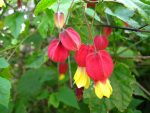 Abutilon is a genus with about 150 species of herbaceous plants, shrubs, and trees native to the tropics and warm temperate areas of the Africa, Asia, Australia and the Americas. It is a member of the mallow family, Malvaeceae, that also includes hibiscus, hollyhock, coffee, cotton, and okra. Although often called flowering maples, the plants are not related to maples and bear little resemblance to them. The plants may be upright or trailing and grow up to 20′ tall in the garden but most species are much smaller especially when grown in containers. The leaves are covered with hair or bristles, have toothed margins, and are attached to the stem by long petioles. In summer the pendulous flowers are carried singly or in pairs at the tips of the branches or in the axils of the leaves and are usually yellow or orange, occasionally rose or pinkish. Each flower is bell-shaped with 5 petals joined at their base and subtended by a 5-lobed calyx. Many hybrids have been developed that differ most significantly in size and flower color. Several species can be grown as perennials in USDA Hardiness Zones 9-10 and also make good house plants in colder areas if given bright light and consistently moist, well-drained soil. One species, China jute (A. theophrasti) is a serious field weed in the US. The genus name Abutilon is the Arabic name for a similar plant. Photo Credit: Wikipedia
Abutilon is a genus with about 150 species of herbaceous plants, shrubs, and trees native to the tropics and warm temperate areas of the Africa, Asia, Australia and the Americas. It is a member of the mallow family, Malvaeceae, that also includes hibiscus, hollyhock, coffee, cotton, and okra. Although often called flowering maples, the plants are not related to maples and bear little resemblance to them. The plants may be upright or trailing and grow up to 20′ tall in the garden but most species are much smaller especially when grown in containers. The leaves are covered with hair or bristles, have toothed margins, and are attached to the stem by long petioles. In summer the pendulous flowers are carried singly or in pairs at the tips of the branches or in the axils of the leaves and are usually yellow or orange, occasionally rose or pinkish. Each flower is bell-shaped with 5 petals joined at their base and subtended by a 5-lobed calyx. Many hybrids have been developed that differ most significantly in size and flower color. Several species can be grown as perennials in USDA Hardiness Zones 9-10 and also make good house plants in colder areas if given bright light and consistently moist, well-drained soil. One species, China jute (A. theophrasti) is a serious field weed in the US. The genus name Abutilon is the Arabic name for a similar plant. Photo Credit: Wikipedia
Trailing Abutilon (A. megapotamicum)
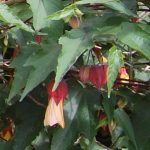 Trailing abutilon is a deciduous or partially evergreen shrub native to Brazil, Argentina, and Uruguay where it grows in dry mountain valleys. Plants grow up to 8′ tall and have small, ovate, pointed leaves 2-3″ long with three shallow lobes. The leaves grow horizontally so the plants tend to have a 2-D appearance. In summer and autumn the pendulous, bell-shaped flowers appear. They are 2-3′ and have a conspicuous bright red calyx and 5 lemon yellow petals surrounding a column of stamens and pistils that extend beyond the petals. Photo Credit: Wikipedia
Trailing abutilon is a deciduous or partially evergreen shrub native to Brazil, Argentina, and Uruguay where it grows in dry mountain valleys. Plants grow up to 8′ tall and have small, ovate, pointed leaves 2-3″ long with three shallow lobes. The leaves grow horizontally so the plants tend to have a 2-D appearance. In summer and autumn the pendulous, bell-shaped flowers appear. They are 2-3′ and have a conspicuous bright red calyx and 5 lemon yellow petals surrounding a column of stamens and pistils that extend beyond the petals. Photo Credit: Wikipedia
Redvein Abutilon (A. pictum)
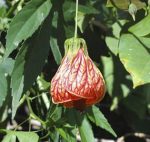 Redvein abutilon is a tender evergreen shrub native to southern Brazil, Argentina, Paraguay and Uruguay but has naturalized in Central American and is a popular ornamental in subtropical areas. Plants grow 3-16′ tall and have 6″ long leaves with 3-5 lobes. From spring to summer 1.6″ long bell-shaped pendant flowers appear that have 5 yellow to orange-red petals with prominent red veining and are attractive to bees and hummingbirds. Photo Credit: Wikipedia
Redvein abutilon is a tender evergreen shrub native to southern Brazil, Argentina, Paraguay and Uruguay but has naturalized in Central American and is a popular ornamental in subtropical areas. Plants grow 3-16′ tall and have 6″ long leaves with 3-5 lobes. From spring to summer 1.6″ long bell-shaped pendant flowers appear that have 5 yellow to orange-red petals with prominent red veining and are attractive to bees and hummingbirds. Photo Credit: Wikipedia
Indian Mallow (A. indicum)
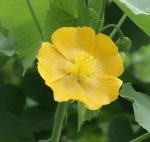
Known in India as atibala, this tender perennial shrub is native to tropical and subtropical areas where it grows in disturbed sites. Plants grow 4-8′ tall from a long tap root and have leaves up to 4″ long that are usually shallowly 3-lobed and hairy. The leaves are broadly ovate to heart-shaped, have coarsely toothed margins, and are carried on long petioles. The yellow chalice-like flowers are about 1″ wide and are carried singly in the leaf axils over a long bloom time in summer. Photo Credit: Wikipedia
Abutilon Hybrids (A. x hybridum)
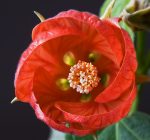 Abutilon hybrids are tender evergreen shrubs and have been popular since the Victorian era. The hybrids usually are 1-4′ tall and have leaves that are unlobed or 3-5 lobed. The leaf edges are toothed and the surfaces smooth or softly hairy underneath. Some cultivars have handsome variegated foliage. The drooping bell-shaped flowers are up to 3″ wide and produced in the leaf axils over a long bloom period from spring until fall. They may be yellow, orange, red, rose, pink, or white, often with conspicuous veining. Plants are best used in containers and can be grown as standards. Photo Credit: Wikipedia
Abutilon hybrids are tender evergreen shrubs and have been popular since the Victorian era. The hybrids usually are 1-4′ tall and have leaves that are unlobed or 3-5 lobed. The leaf edges are toothed and the surfaces smooth or softly hairy underneath. Some cultivars have handsome variegated foliage. The drooping bell-shaped flowers are up to 3″ wide and produced in the leaf axils over a long bloom period from spring until fall. They may be yellow, orange, red, rose, pink, or white, often with conspicuous veining. Plants are best used in containers and can be grown as standards. Photo Credit: Wikipedia